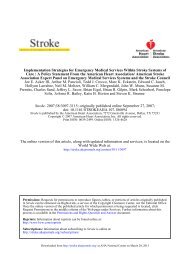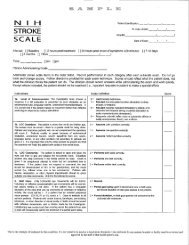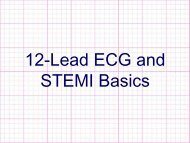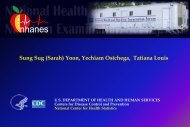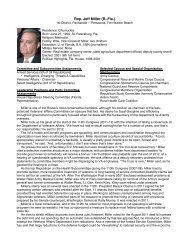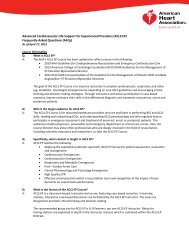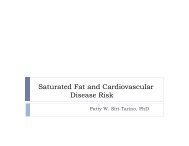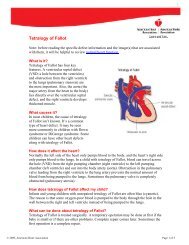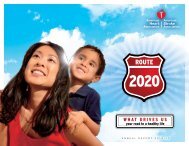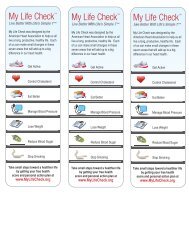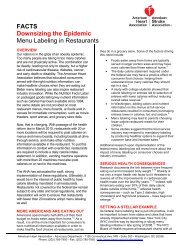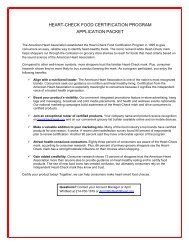Teacher's Resource Guide - American Heart Association
Teacher's Resource Guide - American Heart Association
Teacher's Resource Guide - American Heart Association
Create successful ePaper yourself
Turn your PDF publications into a flip-book with our unique Google optimized e-Paper software.
SM<br />
WE JUMP. WE SHOOT.<br />
WE SAVE.<br />
learning about heart health<br />
Middle middle School school teacher’s resource <strong>Guide</strong> guide
teacher’s <strong>Guide</strong><br />
The <strong>American</strong> <strong>Heart</strong><br />
<strong>Association</strong> and YOU!<br />
Working for Kids’ Health<br />
Our children are precious. We’d do anything to protect them, care for them and make them happy. We’d also do anything to<br />
make sure they live long, healthy lives. That’s why the <strong>American</strong> <strong>Heart</strong> <strong>Association</strong> dedicates so many resources to improving<br />
children’s health.<br />
Read on for educational scripts and discussion prompts to help you teach your students about their hearts, nutrition, physical<br />
activity and how they can protect their health.<br />
With your support, we can help protect and improve children’s health. Your efforts to educate your<br />
students and raise funds for world-class research and outreach are vital to improving kids’ lives.<br />
The Challenge — the Facts<br />
Some Are Born With It — Congenital <strong>Heart</strong> Defects<br />
Congenital heart defects are the most common form of infant death from birth defects.<br />
• Each year about 36,000 babies are born with a heart defect.<br />
• Each year nearly twice as many children die from congenital cardiovascular defects as from all forms of childhood<br />
cancers combined.<br />
Many children are alive today because of treatments not available even 10 years ago. Thanks to your efforts, world-class research<br />
and advancements funded by the <strong>American</strong> <strong>Heart</strong> <strong>Association</strong> have saved and changed their lives.<br />
Others Acquire Risk — An Alarming Trend<br />
While some kids are born with heart problems, others are at risk of developing them because of poor nutrition and lack of<br />
physical activity. Sadly, childhood obesity has reached epidemic proportions.<br />
• Today, nearly one in three <strong>American</strong> kids and teens is overweight or obese.<br />
• Obesity and being overweight have a negative impact on almost every organ system in the body.<br />
• Children who are overweight from the ages of seven to 13 may develop heart disease as early as age 25.<br />
• Children in their early teens who are obese have arteries similar to 45-year-olds.<br />
• Obesity takes a physical toll and also often causes children to suffer from low self-esteem, negative body image<br />
and depression.<br />
Diabetes and <strong>Heart</strong> Disease<br />
Diabetes makes the risk for heart attack especially high. At least 65 percent of people with diabetes die of some form of heart<br />
disease or stroke when the disease is left untreated.<br />
• As many as 45 percent of children with newly diagnosed diabetes have type 2 rather than type 1 (previously called<br />
juvenile diabetes), which is largely preventable with healthy diet and physical activity.<br />
To learn more, visit americanheart.org/healthierkids.<br />
1
teacher’s <strong>Guide</strong><br />
The Solution — Your Money at Work<br />
Research, Outreach and Education<br />
The funds you help raise are vital for protecting today’s children and future generations from the struggles of heart disease<br />
and poor health. We tackle the issues of congenital heart defects, poor nutrition and lack of physical activity by investing<br />
in research, professional and public education, and community service programs. Dollars raised through Jump Rope<br />
For <strong>Heart</strong> and Hoops For <strong>Heart</strong> are used to help children, communities and schools through <strong>American</strong> <strong>Heart</strong> <strong>Association</strong><br />
initiatives such as:<br />
• World-class Research: Ongoing discovery of new treatments, technologies and preventions are vital to saving and<br />
changing lives. The <strong>American</strong> <strong>Heart</strong> <strong>Association</strong> has committed more than $76.2 million for research projects related<br />
to children since 2003.<br />
• PE in Schools: Volunteers and staff advocate at the federal and state levels to support quality physical education<br />
for all public school children through grade 12.<br />
• School Nutrition: We support national- and state-level legislation so schools will offer healthier food choices to students<br />
and staff. Getting more fresh fruits and vegetables in schools will help reduce obesity, high blood pressure, diabetes<br />
and other risk factors for heart disease and stroke.<br />
• Childhood Obesity: Numerous national and community-based<br />
programs are educating children and families on the risks of obesity<br />
and empowering them to take action against it.<br />
• CPR in Schools: CPR can make the difference between the life and<br />
death of a loved one. With Be the Beat (bethebeat.heart.org), our<br />
children can become the next generation of lifesavers.<br />
WE REACH OUT TO KIDS WHERE THEY LIVE, LEARN AND PLAY.<br />
Vicky Worrell<br />
President, <strong>American</strong> Alliance for Health, Physical Education, Recreation and Dance<br />
“AAHPERD is privileged to continue the 30-plus year collaboration with AHA. Jump Rope For <strong>Heart</strong> and<br />
Hoops For <strong>Heart</strong> are first-class service learning events that provide students, staff, and parents the<br />
opportunity to volunteer, be physically active and educate students on heart health. At the same time,<br />
these events assist with a healthcare initiative that raises funds used for critical medical research<br />
related to cardiovascular disease and stroke.”<br />
Nancy Brown<br />
CEO, <strong>American</strong> <strong>Heart</strong> <strong>Association</strong><br />
“Thank you so much for your support of our Jump Rope/Hoops For <strong>Heart</strong> program. Our association<br />
has set an ambitious 10-year goal to improve cardiovascular health and save lives. Jump Rope/<br />
Hoops For <strong>Heart</strong> is vitally important to reach this goal. By learning about cardiovascular diseases<br />
and prevention, students will be able to make better choices to safeguard their health. And by<br />
raising funds for research and programs, they will help us all live longer, healthier lives.”<br />
Investing in the health and wellness of students has a proven return on investment. Numerous studies<br />
link healthy lifestyles with improved test scores, reduced absenteeism, increased attention spans,<br />
improved behavioral performance, financial benefits, increased self-esteem, better attitudes and happier,<br />
healthier students and staff.<br />
2
teacher’s <strong>Guide</strong><br />
How the <strong>Heart</strong> Works<br />
Use this information to teach about the heart and how it works. Learning how important the heart is to their<br />
bodies will motivate students to keep their hearts healthy and strong!<br />
SUPERIOR VENA CAVA<br />
FROM UPPER BODY<br />
FUN FACT: Your heart is a hard<br />
worker! It pumps fresh blood<br />
to every cell in your body in<br />
less than 60 seconds.<br />
PULMONARY ARTERY<br />
TO RIGHT LUNG<br />
PULMONARY VEIN<br />
FROM RIGHT LUNG<br />
AORTA<br />
TO UPPER BODY<br />
TO LOWER BODY<br />
PULMONARY ARTERY<br />
PULMONARY ARTERY<br />
TO LEFT LUNG<br />
PULMONIC VALVE<br />
RIGHT<br />
ATRIUM<br />
LEFT<br />
ATRIUM<br />
MITRAL VALVE<br />
AORTIC VALVE<br />
PULMONARY VEIN<br />
FROM LEFT LUNG<br />
TRICUSPID VALVE<br />
LEFT<br />
VENTRICLE<br />
RIGHT<br />
VENTRICLE<br />
INFERIOR VENA CAVA<br />
FROM LOWER BODY<br />
Did you know your heart is a muscle? It is! It’s about the size of your fist, and it sits in the middle of your chest, slightly<br />
tilted to the left.<br />
Your heart is different from all your other muscles. It’s made of a special type of muscle, called cardiac muscle, not<br />
found anywhere else in your body. Cardiac muscle is a type of muscle called involuntary muscle. That means you<br />
don’t have to do anything to make it work. For example, you don’t automatically raise your hand in class. You THINK with<br />
your brain that you WANT to raise your hand and your brain sends a message to your arm muscles and your hand goes<br />
up. Unlike your arm muscles, your heart beats without you thinking about it — it’s involuntary.<br />
3
teacher’s <strong>Guide</strong><br />
How the <strong>Heart</strong> Works<br />
The heart is a pump that pushes blood all over the body. The movement of blood<br />
through the body is called circulation, and the heart is the pump that makes the<br />
circulatory system work. When the heart pumps (or beats), it’s sending blood<br />
through the body to pick up waste and deliver oxygen<br />
There are four rooms in the heart. These rooms are called chambers.<br />
The two right chambers receive blood from all over the body and send it to the lungs<br />
to drop off waste from organs and other cells and to pick up oxygen. Once blood<br />
leaves the lungs with oxygen, it gets sent back into the left side of the heart, which<br />
pumps it back to the body. There is a special wall down the middle of the heart,<br />
separating the heart’s right and left sides. This wall is called the septum.<br />
Each side of the heart has two chambers, one on top and one on the bottom. The chambers on the top are called the atria (or atrium,<br />
singular). The chambers on the bottom are called ventricles. The atria act as receivers for the heart. The right atrium receives<br />
blood from the body, and the left atrium receives blood from the lungs. The atria then pass the blood down to the ventricles, which<br />
push it out to the lungs (right) or the body (left). At the exact same time that the ventricles are pushing blood out to the body, the<br />
atria are refilling, ready for the next pump. Your heart never takes a break!<br />
You may be wondering how the blood gets from one chamber to another. The heart has four special doors called valves that open<br />
to let blood flow into each chamber. These valves are very special because they only let the blood go forward.<br />
So, where does the blood go once it leaves the heart? Blood leaves the heart through the largest blood vessel in the body, the aorta.<br />
The aorta sends the blood out all over the body in an elaborate network of tubes called blood vessels. Three types of blood vessels<br />
are arteries, veins and capillaries.<br />
• Arteries carry blood from the left ventricle away from the heart and deliver oxygen<br />
and nutrients to the body. Arteries are red because when blood is full of oxygen, it<br />
turns red.<br />
• Veins carry blood back to the right atria from the body. Blood returning to the heart<br />
in veins carries carbon dioxide and other wastes from the body. Veins are blue,<br />
because blood that does not have any oxygen in it is blue.<br />
LEARNING CONNECTION: What word<br />
does “circulatory” sound like?<br />
Circle! Blood in the circulatory<br />
system makes a big circle inside<br />
the body. The heart pumps blood<br />
through this circle.<br />
LEARNING TIP: Help students<br />
remember that arteries take<br />
blood away from the heart<br />
because both “arteries” and<br />
“away” start with an “A.”<br />
• Capillaries connect arteries and veins. They are the smallest blood vessels in the body. The capillaries have very thin walls<br />
with tiny holes (called pores) that allow oxygen and other nutrients to diffuse OUT of the blood and into the cells to feed<br />
the body. At the same time, carbon dioxide and other wastes transfer INTO the blood to be carried back to the lungs to be<br />
exhaled. Capillaries are where the blood turns from red to blue because oxygen leaves.<br />
fun facts<br />
• The heart beats about 100,000 times per day, or 35 million times a year.<br />
• The adult heart pumps about five quarts of blood each minute. That’s about 2,000 gallons per day!<br />
• The human heart creates enough pressure to squirt blood 30 feet!<br />
• When you hear a “heartbeat,” you’re hearing the sound of your heart’s valves opening and closing as they push blood<br />
through each of the heart’s chambers.<br />
• A woman’s heart weighs about 8 ounces (about as much as a cup of sugar). A man’s heart weighs about 10 ounces (about<br />
as much as a large orange). Women’s hearts beat faster than men’s hearts.<br />
• Your heart muscle contracts and relaxes about 70 times per minute.<br />
• Laughter really is the best medicine. Studies show that the lining of blood vessel walls relaxes for up to 45 minutes after a<br />
good laugh, which increases blood flow to the body.<br />
• At rest, the heart works twice as hard as the leg muscle of a sprinting man.<br />
Visit bethebeat.heart.org for more information and fun facts.<br />
4
teacher’s <strong>Guide</strong><br />
how the heart works<br />
Just like your other muscles, your cardiac muscles need exercise. Giving your heart regular workouts will keep it<br />
pumping strong.<br />
How do you know if your heart is working? By feeling your pulse! As your heart pumps blood through your body, you<br />
can feel it pulsing. It’s an up-and-down feeling of the blood vessels, or arteries, close to the skin’s surface in places<br />
such as your wrist, neck and upper arm. These places are called pulse points.<br />
What is your pulse? Your pulse tells you how fast or slow your heart is beating — also called your heart rate. Your pulse<br />
is the number of times your heart beats each minute (what scientists call “beats per minute” or bpm).<br />
Why is your pulse so important? Your pulse can tell you how well your heart is working. It can be used to help find the<br />
cause of problems such as dizziness, fainting, chest pain, shortness of breath or other conditions. If your pulse is too<br />
fast or too slow, it can also provide other information about your health.<br />
How do you check your pulse? Checking your pulse is a simple way to find out how fast or slow your heart is beating. You<br />
can find your pulse in a few places on your body. The easiest places to check your pulse are your wrist and your neck.<br />
Doctors and scientists say that you need to exercise your heart for at least 60 minutes every day. So, how do you know<br />
if you’re giving your heart a good workout? Low-intensity activities don’t require your heart to work as hard, while<br />
moderate or vigorous activities can make your heart work harder. Lower-intensity activities (like reading) don’t give<br />
your heart as good a workout as moderate or vigorous activities (like running, swimming, or playing lacrosse). A good<br />
way to determine if you’re getting a moderate to vigorous workout is if you’re breathing hard and breaking a sweat —<br />
that means your heart is really pumping!<br />
After explaining pulse and pulse rate to students, do this quick activity to illustrate what they’ve learned:<br />
Make sure students have been relaxed and calm for 10 minutes. Have them take their<br />
resting pulse rate using the instructions below. (Note: A typical resting pulse for 8–12<br />
year-olds is 60–140 bpm.)<br />
Have students do 2 minutes of a high-intensity physical activity such as kangaroo<br />
hops from side-to-side over a line on the floor, running in place or around the gym<br />
or dancing to music, then check their pulse again.<br />
Ask students what difference they noticed from their resting pulse rate and their active<br />
pulse rate. Their active pulse rate should be much higher because their heart was<br />
getting a workout!<br />
Remind students that getting their heart beating is how it gets exercise. It’s important<br />
to give your heart a workout EVERY DAY to keep it healthy. If you are active until you<br />
break a sweat, you’re giving your heart a good workout.<br />
To measure the pulse on your wrist (radial):<br />
1. Hold your hand in front of you.<br />
2. Gently place two fingers of your other hand on the inside of your wrist, at the top.<br />
DO NOT USE YOUR THUMB — IT HAS ITS OWN PULSE.<br />
3. Move your fingers around until you feel a steady beat.<br />
4. Now count the beats for 15 seconds and multiply that number by 4 to get your<br />
pulse. For example, if you counted 20 beats during the 15 seconds, your pulse<br />
would be 80 bpm (20 × 4).<br />
To measure the pulse on your neck (carotid):<br />
1. Gently place two fingers (not your thumb) just below your jaw and<br />
to either side of your windpipe.<br />
2. Move your fingers around until you feel a steady beat.<br />
3. Count the beats for 15 seconds and multiply that number by 4 to get your pulse.<br />
For example, if you counted 20 beats during the 15 seconds, your pulse would<br />
be 80 bpm (20 × 4).<br />
5
teacher’s <strong>Guide</strong><br />
How the <strong>Heart</strong> Works<br />
Sudden Cardiac arrest<br />
What makes the heart beat? It’s electric — no joke! There are some very special cells in the heart that can generate electrical<br />
current, and that’s what signals the heart to contract. Starting in the right atrium, a network of nodes and fibers conduct electricity<br />
around the heart. The electrical signal from a node causes the right and left atrium to contract at the same time. This squeezes<br />
blood down to the ventricles. Then the signal travels down fibers to the left and right ventricles, causing them to contract together.<br />
When the ventricles contract, they pump blood out from the heart.<br />
Sometimes the electrical signals in the heart get disrupted. This can keep the heart from pumping properly, which is very dangerous.<br />
Sudden cardiac arrest happens when a heart suddenly stops beating normally and a person collapses. CPR can help keep a cardiac<br />
arrest victim alive. It helps keep blood flowing to the brain and heart until a shock from an Automated External Defibrillator can<br />
be delivered. An AED is a portable, computerized medical device that checks a person’s heart rhythm, recognizes a rhythm that<br />
requires a shock and advises the rescuer when a shock is needed. The AED sends a shock of electrical current to the heart to<br />
stop the bad rhythm and allow a normal, healthy rhythm to resume.<br />
Hands-only cpr can save a life<br />
If you see someone 8 years or older suddenly collapse, don’t just stand there! Call 9-1-1 and push hard and fast in the center of<br />
the chest. Keep pushing hard and fast until an AED arrives and is ready to use, or EMS arrives and takes over care for the victim.<br />
It’s called Hands-Only CPR and anyone can do it! You just need to remember two important steps: Call 9-1-1 and push hard and<br />
fast on the chest. Remember, this is only for people 8 years and older. Younger kids who collapse suddenly may need the<br />
oxygen that full CPR provides. Babies (up to 1 year old) and children (1–8 years old) who are unresponsive most likely have a<br />
breathing-related issue. So, a baby or young child who becomes unresponsive needs CPR with breaths until EMS arrives and<br />
takes over care for the victim.<br />
In communities with high rates of bystander CPR and effective systems for responding to cardiac emergencies, cardiac arrest<br />
survival rates are as high as 46%.<br />
Unless CPR is started immediately following collapse and a shock from an AED is given within the first few minutes, few attempts<br />
to bring that person back to life are successful. Unfortunately, only one in three people who have cardiac arrest outside of the<br />
hospital get CPR from a bystander. But a person’s chance of survival can double or triple if effective CPR is started right away.<br />
be the beat<br />
The <strong>American</strong> <strong>Heart</strong> <strong>Association</strong> is helping create the next generation of<br />
heart heroes by teaching tweens and teens the simple steps to save a<br />
life with Be the Beat.<br />
Kids can find FREE games, music, videos and giveaways — to educate them<br />
while they have fun at BetheBeat.heart.org.<br />
Educators, administrators, school nurses and coaches will find valuable<br />
information to start and sustain CPR and AED programs, emergency response<br />
planning and other programs that help make our schools safer<br />
for our children at BetheBeat.heart.org/schools.<br />
Check out BetheBeat.heart.org to learn more about CPR and how to<br />
use an AED.<br />
Wrap up this activity with a few discussion questions:<br />
1. Now that you know how important your heart is in your body,<br />
does it make you want to take care of it more?<br />
2. What should you do if you see someone suddenly collapse?<br />
3. What is Hands-Only CPR?<br />
4. Where can you go to learn more about Hands-Only CPR and to<br />
learn about joining the movement of heart heroes?<br />
5. What does AED stand for and how does it work?<br />
6
teacher’s <strong>Guide</strong><br />
what is a heart attack?<br />
Use this information to teach kids about heart attack and how to recognize the signs of someone having one.<br />
The heart pumps blood full of oxygen and other nutrients to all parts of the body, but the heart muscle needs oxygen and<br />
nutrients too. The arteries that supply the heart muscle with blood are called coronary arteries.<br />
In a healthy person, blood flows freely through the blood vessels (arteries and veins). It’s kind of like the plumbing system in<br />
your house. When everything is working correctly, water comes through the pipes and gets carried away through drains.<br />
Unhealthy habits, like not getting enough physical activity, can cause our internal pipes — our blood vessels — to get clogged.<br />
When this happens, fatty deposits called plaque build up inside the blood vessel walls. Over time, if enough plaque builds up,<br />
the arteries, which are normally flexible and elastic, can become hard. This is called “hardening of the arteries” or arteriosclerosis.<br />
When the arteries get hard and clogged up, it causes two problems:<br />
1. The clog leaves less space for blood to flow through the vessel, or totally blocks it.<br />
2. The clog leaves a rough spot inside the artery that actually attracts other gunk, making the clog bigger. This can form<br />
a clot. The clot can block the blood flow at that spot or break free from the artery wall and travel until it gets stuck in<br />
a narrow space.<br />
If either of these things happens, the artery can’t deliver the oxygen and nutrients to the heart and the muscle starts to die.<br />
This is a heart attack.<br />
heart attack vs.sudden cardiac arrest<br />
Sudden cardiac arrest is an electrical problem, when the heart suddenly stops beating normally and pumping blood to the<br />
brain and vital organs. In most cases, there are no warning signs or symptoms and someone will collapse suddenly.<br />
When sudden cardiac arrest occurs, the victim may collapse, doesn’t respond to gentle shaking, stops normal breathing<br />
and, after two rescue breaths, still isn’t breathing normally, coughing or moving.<br />
Cardiac arrest strikes immediately and without warning. Victims can go from standing and talking to suddenly flat on the ground.<br />
A heart attack is a “plumbing” problem caused by a blockage in the heart’s blood vessels, causing the heart muscle to die.<br />
Symptoms include chest pain; pain in left arm, between shoulder blades, and/or jaw; difficulty breathing; dizziness, nausea<br />
and vomiting; and sweating. Usually there is more warning with a heart attack and people have time to get to a hospital<br />
while they are still conscious.<br />
When blood flow is severely reduced in coronary arteries (the blood vessels that bring blood to the heart muscle itself), it<br />
can cause a heart attack.<br />
<strong>Heart</strong> attacks, drowning, drug overdose and any problem that prevents someone from breathing can lead to a cardiac arrest.<br />
In a cardiac arrest, seconds count. That person does not have adequate blood pumping to vital organs. Immediate CPR is<br />
vital to help keep the person alive until help or an AED arrives.<br />
7
teacher’s <strong>Guide</strong><br />
Six Controllable Risk Factors for <strong>Heart</strong> Disease<br />
Some things we can’t control, but several key risk factors for heart disease can be controlled through lifestyle<br />
choices. Teach students how to reduce their risk for cardiovascular disease by controlling these six risk factors.<br />
Some things about our bodies were passed on to us by our parents through genetics. These are things like what color<br />
your eyes are, how tall you are or if you have curly hair. We can’t change these things. Having a family member with<br />
certain health problems can increase your risk for having those conditions too.<br />
The good news is, even though some problems can be passed on from your parents, making healthy choices can<br />
decrease your chances of developing some diseases.<br />
Here are some things you can work on to lower your odds of getting heart disease:<br />
• Smoking — Don’t ever do it. Cigarettes are very bad for your health. Smoking can cause cancer, lung disease<br />
and heart disease. Over time, cigarette smoke destroys your lungs and blood vessels, making it hard for blood to<br />
deliver oxygen and nutrients to your organs.<br />
• High blood pressure (hypertension) — People whose blood pressure is above a normal range are said to have<br />
high blood pressure, or hypertension. This causes the heart to pump harder than normal to push blood through the<br />
body. High blood pressure has no warning signs, so everyone should have their blood pressure checked regularly.<br />
High blood pressure can be reduced by increasing physical activity, making healthy food choices and staying at a<br />
healthy weight.<br />
• High cholesterol — Too much cholesterol in the blood raises the risk for heart disease. Some cholesterol comes<br />
from the food we eat. By eating foods low in fat and cholesterol, we can reduce the amount of bad cholesterol in<br />
our bodies.<br />
• Physical inactivity — Not getting enough regular physical activity is bad for the heart. Your heart muscle needs<br />
to work out to stay in shape, so be physically active for at least 60 minutes every day. Not getting enough regular<br />
physical activity is linked to high cholesterol, high blood pressure, diabetes and being overweight.<br />
• Obesity and overweight — Being overweight isn’t about how you look on the outside. It can lead to serious<br />
problems inside like high blood cholesterol, high blood pressure and diabetes. Eat right and get physically active<br />
to maintain a healthy weight!<br />
• Diabetes — There are two main types of diabetes, type 1 and type 2. Type 1 diabetes is a problem people can be<br />
born with, but type 2 (the most common type) develops later. Being overweight and physically inactive are two<br />
things that cause type 2 diabetes. Diabetes can cause problems for the body and increase the risk for heart disease.<br />
These risk factors can be confusing, but by doing three simple things,<br />
you reduce your chance for all six of them!<br />
1. Don’t smoke.<br />
2. Eat a healthy diet — lots of colorful fruits and veggies.<br />
3. Get at least 60 minutes of physical activity every day.<br />
8
teacher’s <strong>Guide</strong><br />
Keep Your Health From Going Up in Smoke<br />
Smoking is the No. 1 cause of preventable death in the United States. Talking to students about the dangers of<br />
smoking can help them decide not to use tobacco products. Use the information below to guide your conversation.<br />
In the United States, tobacco kills more <strong>American</strong>s than car accidents, murder, AIDS, drugs<br />
and fires combined. Smoking cigarettes or using smokeless tobacco (also called dip, snuff<br />
or chew) is one of the worst things you can do to your body. Smoking damages nearly every<br />
organ in the body, including your heart, and causes heart disease and cancer.<br />
Smoking also causes some gross side effects, such as bad breath, stinky clothes, coughing,<br />
yellow teeth and difficulty breathing.<br />
Why is smoking so bad? Tobacco contains a chemical called nicotine that gives smokers a brief pleasant feeling. People<br />
get addicted to that good feeling. In addition to the nicotine, tobacco has lots of other poisonous chemicals in it. These<br />
toxic substances destroy your body over time, especially your heart and lungs.<br />
Some of the 4,000 chemicals found in cigarette smoke are also found in other familiar things:<br />
Acetone — nail polish remover<br />
Cadmium — batteries<br />
Hydrogen cyanide — rat poison<br />
Hydrazine — rocket fuel<br />
Urea — pee and sweat<br />
Toluene — gasoline<br />
Methanol — antifreeze<br />
The nicotine and other chemicals in cigarette smoke damage blood vessels and make it harder for the blood to move around<br />
the body. When blood doesn’t move around freely, your body doesn’t get as much oxygen as it needs. The chemicals in smoke<br />
also make your blood sticky and more likely to form a clot, which can result in a heart attack or stroke. Cigarette smoke can<br />
also keep your lungs from growing when you’re young, so it’s especially important for kids and teens not to smoke.<br />
Secondhand smoke is the smoke a person breathes from being around someone who is<br />
smoking. Some people think secondhand smoke isn’t dangerous, since they aren’t smoking.<br />
The truth is, secondhand smoke is harmful to your body. If you are around people who<br />
smoke, ask them not to smoke near you. Or try to move away from the smoke.<br />
Wrap up this activity with a few discussion questions:<br />
1. What can you do if someone offers you a cigarette?<br />
2. What is one reason why YOU don’t want to smoke cigarettes?<br />
DID YOU KNOW? Every<br />
6.5 seconds, someone in<br />
the world dies from a<br />
smoking-related disease.<br />
DID YOU KNOW? Cigarette<br />
smoking almost doubles a<br />
person’s risk for stroke.<br />
The <strong>American</strong> <strong>Heart</strong> <strong>Association</strong> offers free tips to quit<br />
smoking. Visit americanheart.org and type “smoking<br />
cessation” or “quit smoking” in the search box.<br />
9
teacher’s <strong>Guide</strong><br />
High Blood Pressure<br />
Peer pressure isn’t the only negative pressure kids may have in their lives. High blood pressure has no symptoms,<br />
so it is critical to teach students about the importance of having it checked regularly.<br />
Blood pressure is a measure of how easy or difficult it is for blood to circulate in the body. More specifically, blood<br />
pressure is the force the blood puts on the walls of the blood vessels (the tubes that carry blood around the body) when your<br />
heart beats. Blood pressure increases when the heart beats and falls when the heart relaxes between beats. Blood pressure is<br />
affected by physical activity, rest, the temperature of where you are, emotions, diet and many other factors.<br />
Having normal blood pressure means blood can travel through the body fairly easily.<br />
DID YOU KNOW? High blood People whose blood pressure is above a normal range are said to have high blood<br />
pressure is the number pressure, or hypertension. Hypertension can increase a person’s risk for cardiovascular<br />
one cause of stroke. disease because blood cannot travel as easily and the heart and blood vessels are<br />
working harder than normal. Hypertension often runs in families, but<br />
maintaining a healthy weight by making healthy food choices and staying physically active for at least<br />
60 minutes per day can help prevent hypertension, even with a family history.<br />
High blood pressure has no warning signs, so it is very important that a doctor, healthcare provider<br />
or nurse check your blood pressure regularly.<br />
You’ve probably had your blood pressure checked at the doctor’s office. Doctors and nurses<br />
measure blood pressure with a sphygmomanometer (sfig-moh-muh-nom-i-ter). It’s a device<br />
that looks like an armband or cuff with a rubber ball on the end. The cuff usually wraps around<br />
one arm with Velcro and the ball is squeezed, forcing air to tighten the cuff. When the cuff is<br />
pumped up, it presses on a large artery in the arm, stopping the blood flow for a moment.<br />
Blood pressure is measured as the air is gradually let out of the cuff, which allows blood to<br />
flow through the artery again. The doctor or nurse will put a stethoscope near the cuff to<br />
hear the first pulse as the blood flows through.<br />
The systolic is the pressure on the artery wall when the heart beats; the diastolic is<br />
the pressure between heartbeats. Your blood pressure is written as a number like this:<br />
110/75 (usually stated as 110 over 75). The first number is the systolic pressure (this<br />
number is always larger because it is when the pressure is greatest, when the heart<br />
pumps). The second number is the diastolic pressure.<br />
If your blood pressure is low, your heart may not be working properly. If your blood pressure<br />
is high, then narrow arteries might be making the heart work harder than it should.<br />
Your body’s blood vessels are<br />
so long, they could circle the<br />
earth more than two times!<br />
Some people need to take medicine to keep their blood<br />
pressure normal. Other people can keep their blood<br />
pressure normal by eating a healthy diet with lots of fruits<br />
and vegetables and by getting enough physical activity<br />
every day.<br />
10
teacher’s <strong>Guide</strong><br />
What is Cholesterol?<br />
Too much of anything can be bad for you. Use this information to teach kids why it is important to know their<br />
cholesterol levels.<br />
Cholesterol is a soft, fat-like, waxy substance found in the bloodstream and in all your body’s cells. Cholesterol is an<br />
important part of a healthy body because it’s used for building cell walls and is needed for other important functions.<br />
Some of the cholesterol we need is produced naturally in the liver and some of it comes from the food we eat. There is no<br />
real need for your body to get cholesterol from food, so it is important to eat as little cholesterol-filled foods as possible.<br />
Too much cholesterol in the blood raises the risk for heart disease. Hypercholesterolemia is the medical term for high<br />
levels of blood cholesterol.<br />
Think of the blood vessels in your body like pipes in your house. If you have too much cholesterol in your blood, it can<br />
collect in the blood vessel walls, causing these “pipes” to clog. This keeps blood from moving freely throughout your<br />
body. Over many years, if the clogging gets worse, it can cause a heart attack or stroke.<br />
healthy<br />
artery<br />
unhealthy<br />
artery<br />
Your doctor, healthcare provider or nurse can find out what your cholesterol level is by taking a little of your blood<br />
and testing it.<br />
To lower your blood cholesterol level, get physically active and watch what you eat. Eat more lean meats like fish or<br />
skinless chicken in place of fatty red meats. Dairy products are important, but they should be from fat-free milk and<br />
low-fat dairy products. To keep your cholesterol level low, look at food labels and try to avoid foods that are high in<br />
saturated fat and cholesterol.<br />
Benefits of Physical Activity<br />
Encouraging some children to be physically active can be a challenge, especially if they don’t enjoy some<br />
activities or don’t consider themselves athletic. It’s important to help all kids find an activity they enjoy and<br />
not to think of exercise as a punishment. Use the information below to teach students about the benefits of<br />
physical activity and motivate them to move more.<br />
Getting physically active is an important part of leading a healthy life. Physical activity has lots of benefits for your body<br />
and mind. Getting regular physical activity keeps your heart muscle healthy and strong and helps you build healthy<br />
muscles, bones and joints. It’s also a good way to help manage and maintain a healthy body weight. It can help you<br />
sleep better, too.<br />
11
teacher’s <strong>Guide</strong><br />
Regular physical activity can help reduce your risk of getting some serious diseases, such as cancer and type 2 diabetes.<br />
It also improves blood pressure and blood cholesterol levels. Finally, regular physical activity can release chemicals<br />
called endorphins in the brain. They can help you feel happier, be more alert, deal better with stress, and be able to<br />
concentrate more on daily activities like doing math or reading.<br />
Experts recommend that you get at least 60 minutes of<br />
moderate to vigorous activity every day. How do you know<br />
if you’re getting moderate to vigorous activity? If you’re<br />
breathing hard and sweating, you’re getting a good workout<br />
that will help your heart.<br />
After you’re physically active, cool down. This lets your body<br />
recover so your heart rate can return to a resting level. Walking<br />
at a slow pace or stretching are good ways to do this. These<br />
are also good ways to relax if you feel overwhelmed at school,<br />
angry at a friend or just stressed out.<br />
Did you know that people who are regularly physically active<br />
are less likely to be injured than people who aren’t regularly<br />
physically active? And the health benefits of physical activity<br />
far outweigh the risks of getting hurt for almost everyone.<br />
What are you waiting for? Get moving! Here<br />
are some of the benefits of regular physical<br />
activity for children and adolescents:<br />
• Better blood circulation in the body<br />
• Maintaining a healthy weight<br />
• Better blood cholesterol levels<br />
• Having more energy<br />
• Sleeping better<br />
• Feeling more confident<br />
• Building stronger muscles<br />
• Being in a better mood<br />
Obesity and being Overweight —<br />
living a heart-healthy life<br />
Talking with students about weight is a very sensitive discussion. If you decide to talk to your students about obesity,<br />
remember to focus on the fact that weight is an important indicator of health. Keep the focus away from looks to<br />
avoid hurting confidence or self-esteem of any student. Avoid suggestions related to a specific weight. Kids should<br />
strive for a healthy lifestyle focused on positive habits like being physically active and eating lots of fruits and<br />
vegetables, not achieving a specific weight.<br />
Being overweight is when a person has more body fat than is healthy. And right now in the United States nearly one in three<br />
kids and teens is considered overweight. Nearly two out of three adults are overweight. That’s a lot of <strong>American</strong>s who aren’t<br />
taking very good care of their bodies.<br />
Being overweight is dangerous for your health. It can lead to serious health problems like diabetes, heart disease, high blood<br />
pressure, asthma or other breathing problems, and even some types of cancer.<br />
The good news is, making small changes in daily life can add up to have a big impact on your health. Here are some things<br />
we can ALL do to keep our bodies strong:<br />
• Get at least nine hours of sleep at night.<br />
• Drink plenty of water every day. Drink very little soda and other sugary drinks.<br />
• Get at least two to three servings of low-fat or fat-free dairy (milk, cheese, yogurt) every day.<br />
• Get physically active for at least 60 minutes every day.<br />
• Eat at least five servings of fruits and vegetables every day.<br />
• Limit TV, computer and video games to less than two hours every day (not counting school work).<br />
12
teacher’s <strong>Guide</strong><br />
Find Balance in Your Diet<br />
A healthy diet is one of the best weapons against heart disease. Good nutritional habits established early in life<br />
stay with us for the rest of our lives. Use the information below to talk to students about eating right. Help them<br />
learn how to make healthy choices and create good habits early on!<br />
Why do you put gas in a car? To give it energy so it can move! Our bodies are like cars; we need fuel to move. Food is<br />
the fuel our bodies use.<br />
Every food we eat has a certain amount of energy in it. We call the energy in food calories. One calorie is one unit of<br />
energy. So when you read on a food label or hear people say a food has 100 calories, they’re talking about how many<br />
units of energy are in that food.<br />
Calories aren’t bad; we all need calories for energy. Everything the body does takes a certain number of calories from<br />
food for fuel (or energy). Your body needs energy just to operate, to do things like make your lungs breathe and your<br />
heart beat. Different activities like running, dancing and skateboarding also require energy.<br />
What happens if you put more gas in your car than it can hold? The gas tank overflows.<br />
When people eat more calories (food) than the body needs for energy, the extra energy gets stored as fat. That’s how<br />
people gain weight. To keep your body in balance, you need to match the amount of energy you put in (food or calories)<br />
with the amount of energy you burn off (how physically active you are). This is called energy balance.<br />
In addition to making sure you’re eating the right number of calories to fuel your body, you need to make sure to get the<br />
right type of foods and amounts for your individual needs. Each type of food helps your body in a different way so it’s<br />
important to choose foods of each type every day:<br />
Grains. Choose whole-grain or whole-wheat products. They have more fiber than white flour products (like white bread)<br />
and white rice. Eat 6–7 ounces every day, mostly from whole-grain, high-fiber foods, like whole-grain breads and<br />
cereals, and pasta.*<br />
Vegetables. Veg out on vegetables — they’re an excellent source of vitamins, minerals and fiber. Eat 2–2½ cups every<br />
day.* Try carrots, spinach, green beans and broccoli.<br />
Fruits. Like vegetables, fruits are a good source of vitamins, minerals and fiber. They’re also a great way to satisfy a sweet<br />
tooth, thanks to their natural sugars. Eat 2 cups every day.* Reach for bananas, apples, pears, peaches and strawberries.<br />
Fats, oils and sweets. Limit fats, oils and sweets as much as possible. Get 3 teaspoons of oils per week. Corn oil,<br />
canola oil, olive oil and safflower oil are good choices.<br />
Dairy. Dairy products like milk, yogurt and cheese are an important source of calcium, which keeps your bones strong.<br />
Make sure to pick fat-free or low-fat dairy products to avoid extra fat that you probably don’t need. Get 3 cups (fat-free<br />
or low-fat) every day.* Check out your fridge for some fat-free or low-fat milk, cheese or yogurt.<br />
Meat, Poultry and Fish. Meat, skinless poultry and fish are great sources of protein, which gives you energy. Be sure<br />
to pick lean meats to avoid getting too much fat. Eat 3–6 ounces every day and eat fish twice a week.* You can get<br />
your protein from chicken, turkey, fish and lean beef.<br />
Nuts, Seeds and Legumes. Eat 4 servings per week.* (1 serving=1½ ounces of nuts, ½ ounce of seeds or ½ cup of<br />
cooked legumes.)<br />
Grains Vegetables Fruits Oils Dairy<br />
Eat 6-7 oz.<br />
every day,<br />
mostly from<br />
whole-grain,<br />
high-fiber foods*<br />
Eat 2-2½ cups<br />
every day*<br />
Eat 2 cups<br />
every day*<br />
Get 3 teaspoons<br />
per week<br />
Get 3 cups<br />
(fat-free<br />
or low-fat)<br />
every day*<br />
Meat, Poultry<br />
& Fish<br />
Eat 3-6 oz.<br />
every day.<br />
Eat fish 2 times<br />
per week*<br />
Nuts, Seeds<br />
& Legumes<br />
Eat 4 servings<br />
per week*<br />
13<br />
Such as: Such as:<br />
whole-grain carrots, spinach,<br />
breads and green beans,<br />
cereals, pasta broccoli<br />
*Based on an 1,800-calorie diet.<br />
Such as:<br />
bananas, apples,<br />
pears, peaches,<br />
strawberries<br />
Such as:<br />
corn oil, canola oil<br />
olive oil,<br />
safflower oil<br />
Such as:<br />
fat-free or<br />
low-fat milk,<br />
cheese, yogurt<br />
Such as:<br />
chicken, turkey,<br />
fish, lean beef<br />
Such as:<br />
almonds, walnuts,<br />
sunflower seeds,<br />
kidney beans
teacher’s <strong>Guide</strong><br />
nutrition labels<br />
Learning to read a nutrition label is an important part of making<br />
healthy food decisions. For the following activity, bring in some<br />
food packages with labels. Students can compare them as you<br />
teach them about some of the key things to look for on a label.<br />
(It’s OK if the packages are empty!)<br />
Reading the label is really the only way to know what you’re<br />
eating. Here are some things to look for on a food label to make<br />
healthy choices:<br />
Serving Size<br />
Check the serving size, especially how many servings there are in<br />
the container. If there are two servings in the package and you eat<br />
the whole thing, you’re eating double the calories and other nutrients<br />
that are listed in the amount per serving on the label.<br />
In general, when you think about the amount of calories in a food per<br />
serving, remember that for a 2,000-calorie diet:<br />
• 40 calories per serving is considered low;<br />
• 100 calories per serving is considered moderate; and<br />
• 400 calories or more per serving is considered high.<br />
Saturated and trans fat<br />
Try to minimize saturated and trans fat. These are both bad fats that<br />
clog arteries. You need to limit your total fat to no more than 25–35<br />
percent of your total daily calories.<br />
Cholesterol and Sodium<br />
The less cholesterol and sodium you eat, the better. The latest<br />
recommendation for sodium is less than 2,300 milligrams per<br />
day for adults and even less for kids, depending on their age.<br />
Sugar<br />
Try to keep sugar low. More sugar means more calories. And sugar<br />
doesn’t contain any vitamins or minerals.<br />
Fiber, Vitamins and Minerals<br />
Make sure you get 100 percent of the fiber, vitamins (including A<br />
and C), calcium, iron and other nutrients you need every day.<br />
14
teacher’s <strong>Guide</strong><br />
Diabetes: What is it?<br />
Because of the obesity epidemic in America, the U.S. Centers for Disease Control and Prevention estimates that<br />
one in three children born in 2000 will develop type 2 diabetes in their lifetime. In vulnerable populations such<br />
as low-income or minority groups, that number increases to one in two. Additionally, 65 percent of people with<br />
diabetes die from some form of heart disease or stroke. Use the information below to teach students about the<br />
severity of diabetes and what they can do to prevent it.<br />
In diabetes, the body has problems with a chemical hormone called insulin. Insulin is important to the body because it<br />
helps turn sugar and other food into energy the body can use. When the body has a problem with insulin, it causes too<br />
much sugar to build up in your blood. Then your body doesn’t get the energy it needs to function properly and it starts<br />
to shut down.<br />
There are two main types of diabetes, type 1 and type 2. Type 1 diabetes means the body does not make enough insulin<br />
to function; it is something people can be born with. But type 2 (the most common type) develops in a person over time<br />
because of bad habits.<br />
Being overweight and not getting enough regular physical activity are two bad habits that can lead to developing diabetes.<br />
People with type 2 diabetes are at risk for problems with almost every part of their body if they don’t take good care of<br />
themselves. Some of these things are:<br />
• <strong>Heart</strong> attack<br />
• Stroke<br />
• High blood pressure<br />
• Eye damage and blindness<br />
To reduce your chances of developing type 2 diabetes, make sure to eat a healthy diet and get at least 60 minutes of<br />
physical activity every day.<br />
Diabetes Warning Signs<br />
• Always being thirsty<br />
• Always being tired<br />
• Always being hungry<br />
• Kidney damage<br />
• Foot damage, even foot amputation<br />
• Hearing problems<br />
• Blurry vision<br />
• Going to the bathroom a lot<br />
• Losing weight quickly<br />
If you notice any of the warning signs, tell a parent, teacher or doctor right away!<br />
15
teacher’s <strong>Guide</strong><br />
promoting physically active lifestyles<br />
Promoting physically active lifestyles to our children is more important than ever. Overweight children and<br />
adolescents are at risk for significant health problems both during their youth and as adults. For instance:<br />
• Overweight children and adolescents are more likely than other children and adolescents to have risk factors<br />
associated with cardiovascular disease (e.g., high blood pressure, high cholesterol and type 2 diabetes).<br />
• Overweight children and adolescents are more likely to become obese as adults.<br />
• Studies document the link between obesity and poor school performance and unhealthy or risky behaviors such<br />
as alcohol use, tobacco use, premature sexual behavior, inappropriate dieting practices and physical inactivity.<br />
• Overweight children and adolescents may experience other health conditions associated with increased weight,<br />
which include asthma, liver problems and sleep apnea.<br />
• Obesity puts children at long-term higher risk for chronic conditions such as stroke; breast, colon and kidney<br />
cancers; musculoskeletal disorders; and gall bladder disease.<br />
Hoops For <strong>Heart</strong> is a national fund-raising event created by the <strong>American</strong> <strong>Heart</strong> <strong>Association</strong><br />
and the <strong>American</strong> Alliance for Health, Physical Education, Recreation and Dance. The<br />
basketball event encourages middle school students to join other students nationwide<br />
to fight heart disease and stroke. By raising funds for the <strong>American</strong> <strong>Heart</strong> <strong>Association</strong>,<br />
participants learn about community service and become engaged in learning<br />
more about how to care for their bodies and establish heart-healthy<br />
lifestyles at a young age. The event is conducted in school by physical<br />
education instructors or coaches and can be scheduled whenever it’s<br />
most convenient.<br />
Once you register, you’ll receive an event kit with everything you<br />
need to conduct a successful Hoops For <strong>Heart</strong> event:<br />
• Step-by-step instructions on scheduling, promoting<br />
and conducting the event<br />
• Educational modules for heart-healthy curriculum<br />
to support heart awareness with the event<br />
• Hands-on training and support from an<br />
experienced <strong>American</strong> <strong>Heart</strong> <strong>Association</strong><br />
staff person or volunteer<br />
16
web resources<br />
Educational Web <strong>Resource</strong>s<br />
for Teachers<br />
www.americanheart.org/jump<br />
The Jump Rope For <strong>Heart</strong> website provides information for<br />
teachers, students and parents about the Jump Rope For <strong>Heart</strong><br />
program. Whether you need jump rope skill instructions or tips for<br />
making your event a success, you can find the information here.<br />
www.americanheart.org/hoops<br />
The Hoops For <strong>Heart</strong> website provides event resources for<br />
coordinators, such as tournament setup suggestions or forms<br />
needed to order thank-you gifts.<br />
www.americanheart.org<br />
The <strong>American</strong> <strong>Heart</strong> <strong>Association</strong> website offers a wide variety of<br />
valuable information including current research developments,<br />
detailed explanations for many diagnoses and heart-healthy tips.<br />
www.BetheBeat.org<br />
This site offers free games, videos, songs and prizes to help kids<br />
learn the simple steps to save a life… while they have fun!<br />
www.BetheBeat.org/schools<br />
This site offers free resources for educators, school nurses and<br />
administrators to help start and sustain CPR programs in school.<br />
www.americanheart.org/healthierkids<br />
These tools for parents, teachers and schools offer ideas, suggestions<br />
and resources to help all kids develop lifelong healthy habits.<br />
www.americanheart.org/NFLPlay60Challenge<br />
The <strong>American</strong> <strong>Heart</strong> <strong>Association</strong> and National Football League have<br />
teamed up to create the NFL PLAY 60 Challenge, inspiring middle<br />
school students to become physically active for at least 60 minutes<br />
every day! Visit the website for in-school ideas for promoting physical<br />
activity, classroom activities and physical activity break ideas.<br />
www.aahperd.org<br />
<strong>American</strong> Alliance for Health, Physical Education, Recreation<br />
and Dance is the <strong>American</strong> <strong>Heart</strong> <strong>Association</strong>’s partner in Jump Rope<br />
For <strong>Heart</strong> and Hoops For <strong>Heart</strong>. AAHPERD is the largest organization<br />
of professionals supporting and helping those involved in physical<br />
education, leisure, fitness, dance, health promotion and education and<br />
all specialties related to achieving a healthy lifestyle.<br />
www.aahperd.org/naspe/physicalbest<br />
Physical Best is a comprehensive health-related fitness education<br />
program of AAHPERD for use in conjunction with existing K–12 physical<br />
education curricula.<br />
www.aahperd.org/naspe/stars<br />
STARS is a program developed by the National <strong>Association</strong> for Sport<br />
and Physical Education. This awards program features five levels of<br />
achievement to recognize outstanding physical education programs<br />
in K–12 schools across America. This is an opportunity to gain national<br />
recognition for your school and your PE teachers by documenting the<br />
excellence of your PE program.<br />
www.pecentral.org<br />
PE Central is ideal for PE teachers. The site offers physical education<br />
curricula, program ideas and resources for teaching children and youth.<br />
www.healthychoices.org<br />
The Healthy Choices for Kids nutrition education program was<br />
created by the growers of Washington state apples. This program<br />
consists of four separate volumes: Eat a Wide Variety of Foods;<br />
Choose a Healthy and Active Lifestyle; Eat Plenty of Fruits, Vegetables<br />
& Grains; and Choose Healthy Snacks.<br />
www.nutritionexplorations.org/index.asp<br />
Sponsored by the Dairy Council, Nutrition Explorations is a great<br />
resource for teachers. It provides nutrition lessons, nutrition news and<br />
FAQs, grade-level ideas and a teacher idea exchange area. The site<br />
also has an extensive section for parents, kids and even the cafeteria<br />
or food service staff.<br />
www.kidsnutrition.org<br />
The USDA/Agricultural Research Service’s Children’s Nutrition<br />
Research Center site contains research, news, calculators (including<br />
children’s BMI calculator), a Portion-Distortion Quiz and an interesting<br />
article on how parents’ attitudes help shape kids’ “athletic identity.”<br />
The site also has a poster gallery where you can download and<br />
print materials.<br />
www.bam.gov/teachers/index.htm<br />
BAM! Body and Mind is a children’s website of the Centers for<br />
Disease Control and Prevention. This teachers’ resource center helps<br />
you to incorporate CDC health, safety and science topics into your<br />
classroom. The site also offers your students interactive content to<br />
investigate topics for school or for a personal interest.<br />
www.health.discovery.com<br />
The Discovery Channel’s online health resource contains news,<br />
health tools, information on diseases and conditions, diet and fitness,<br />
and even podcasts.<br />
17
web resources<br />
Educational Web<br />
<strong>Resource</strong>s for students<br />
www.kidshealth.org<br />
KidsHealth is the largest and most-visited site on the Web providing<br />
doctor-approved health information about children from before<br />
birth through adolescence. Created by The Nemours Foundation’s<br />
Center for Children’s Health Media, KidsHealth provides families<br />
with accurate, up-to-date and jargon-free health information they<br />
can use. The site offers games and activities for kids as well as<br />
advice for teens.<br />
www.healthyfridge.org<br />
A website devoted to bringing awareness to the importance of healthy<br />
eating habits and developing those healthy habits at an early age. The<br />
site offers fun activities and information for parents and teens.<br />
www.nutritionexplorations.org/kids/main.asp<br />
The Dairy Council’s site is filled with games, activities, contests, a<br />
kids’ panel, recipes and fun links. It helps kids explore the world of<br />
nutrition and learn healthy eating habits.<br />
www.mypyramid.gov/kids/index.html<br />
This site contains the principles of the latest Food Pyramid worded<br />
for kids. It has resources for parents, games for kids and information<br />
for teachers. There are posters to download and tips on nutrition and<br />
physical activity.<br />
www.bam.gov<br />
BAM! Body and Mind is a children’s website of the Centers for<br />
Disease Control and Prevention. This site has an interactive Create<br />
Your Own Fitness Calendar feature for kids to make a personalized<br />
calendar of the activities they are planning to do as well as a recipe<br />
finder for healthy snacks. There are also activity cards that show<br />
how different activities affect the body.<br />
Advocacy<br />
web resources<br />
www.americanheart.org/yourethecure<br />
You’re the Cure is the <strong>American</strong> <strong>Heart</strong> <strong>Association</strong>’s nationwide<br />
network of people dedicated to finding a cure for heart disease and<br />
stroke. You’re the Cure when you speak up for vital research funding,<br />
or when you advocate for public policies that increase physical<br />
activity and improve nutrition in schools. You’ll get everything you<br />
need to succeed, including a Welcome Packet to get you started.<br />
Timely action alerts ask you to call, write or visit policymakers when<br />
an important issue is being decided.<br />
www.nchealthyschools.org/docs/schoolhealth<br />
advisorycouncil/advisorycouncilsmanual.pdf<br />
The North Carolina Healthy Schools Program has put together a<br />
comprehensive guide to create effective school health advisory councils.<br />
www.walkinginfo.org/problems/<br />
Walkinginfo.org has a checklist to determine if your neighborhood is<br />
a friendly place to walk. It will also give you suggestions on how to fix<br />
problems that you find.<br />
http://member.aahperd.org/advocacy<br />
The AAHPERD Legislative Action Center provides information and<br />
resources needed to address the health, physical activity, dance and<br />
sport issues being debated on Capitol Hill. In addition, this site serves<br />
as an election, media and training resource.<br />
www.tobaccofreekids.org<br />
This site by the Campaign for Tobacco-Free Kids offers information<br />
on state and federal initiatives, research, facts and special updates on<br />
how to keep kids from trying cigarettes.<br />
18
Take Steps toward a Healthier School<br />
Wellness Councils and Wellness Policies<br />
The 2004 reauthorization of the Child Nutrition Program required all districts participating in the National School Lunch<br />
Program to create a local wellness policy that addresses nutrition and physical activity by the start of the 2006–07<br />
school year.<br />
In addition, this federal legislation mandated that a committee be formed to create the local policy. Many states also<br />
require the formation of local school wellness councils or school health advisory councils. Wellness councils bring<br />
school staff, families, students and community members together to address pressing student health issues.<br />
Interested in getting involved in your school’s wellness efforts? The Alliance for a Healthier Generation Healthy Schools<br />
Program has the resources you need to start, lead or join a wellness council. Go to healthiergeneration.org/schools/<br />
wellness/ for FREE information, tips, templates and tools.<br />
Still have questions? E-mail the Healthy Schools Program at schools@healthiergeneration.org.<br />
AMERICANHEART.ORG/HOOPS<br />
©2010, <strong>American</strong> <strong>Heart</strong> <strong>Association</strong>. Also known as the <strong>Heart</strong> Fund. This resource guide supports the Jump Rope For <strong>Heart</strong> and Hoops For <strong>Heart</strong> programs. 06-3633 5/10



